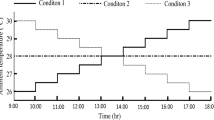Abstract
The age-related features of the circadian rhythm of skin temperature were studied using the Termochron iButton method in two age groups of subjects: eight-to nine-year-old boys and girls and young men and women aged 20–22 years. For this purpose, the temperature was monitored for 48 h at a recording interval of 10 min. The following authentic chronobiological differences were revealed: the temperature mesor was higher in the girls than in the boys and in the young men it was higher than in the young women. The circadian rhythm’s amplitude was higher in the boys and the young women. Studies of the chronological values in different 24-h periods showed that the average level of temperature at night was lower in all subjects. The amplitude in the adults did not differ in different 24-h periods, whereas it was higher in the children at night.
Similar content being viewed by others
References
Gubin, G.D., Gubin, D.G., and Kulikova, S.V., Human Body Temperature as a Chronobiological Problem. Theoretical and Practical Aspects, in Tsikly (Cycles) (Proc. III Int. Conf.), Stavropol: SevKavGTU, 2001.
Redfern, P., Minors, D., and Waterhouse, J., Circadian Rhythms, Jet Lag, and Chronobiotics: An Overview, Chronobiol. Intern., 1994, vol. 11, p. 253.
Reinberg, A., Chronobiologie et morbidite, Ann. Med. Intern., 1980, vol. 131, no. 4, p. 517.
Refinetti, R. and Menaker, M., The Circadian Rhythm of Body Temperature, Physiol. Behav., 1992, vol. 51, p. 613.
Dijk, D.J. and von Schantz, M., Timing and Consolidation of Human Sleep, Wakefulness, and Performance by Symphony Oscillators, J. Biol. Rhythms, 2005, vol. 20, no. 4, p. 279.
Deryapa, R.R., Moshkin, M.P., Postnyi, V.S., et al., Problemy meditsinskoi bioritmologii (The Problems of Medical Biorhythmology), Moscow: Meditsina, 1985.
Putilov, A.A., Sovy, “zhavoronki” i drugie. O nashikh vnutrennikh chasakh i ikh vliyanii na zdorov’e i kharakter (Night and Morning Persons and Others: Our Internal Clock and Its Influence on Health and Character), Moscow: Sovershenstvo, 1997.
Hildebrandt, G., The Time of Adaptation, Int. J. Chronobiol., 1981, vol. 7, no. 4, p. 254.
Doskin, V.A. and Kuindzhi, N.N., Biologicheskie ritmy rastushchego organizma (Biological Rhythms of a Growing Body), Moscow: Meditsina, 1989.
Pronina, T.S. and Rybakov, V.P., Day-Night Dynamics of Skin Temperature in Nine- to Ten-Year-Old Boys and Girls, Al’manakh Nov. Issled., 2008, no. 4, p. 72.
Davis, F., Ontogenesis of Circadian Rhythms, Biologicheskie ritmy (Biological Rhythms), Ashoff, Yu., Ed., Moscow: Mir, 1984, vol. 1, p. 292.
Hellbrugge, T., The Development of Circadian and Ultradian Rhythms of Premature and Full-Term Infants, Chronobiology, Scheving, L.E., Halberg, F., and Pauly, J.E., Eds., Tokyo: Iguku Shoin,1974.
Kripke, D.F., Youngstedt, S.D., Elliott, J.A., et al., Circadian Phase in Adults of Contrasting Ages, Chronobiol. Int., 2005, vol. 22, no. 4, p. 695.
Tsujimoto, T., Circadian Rhythms in Depression, Affect. Disord., 1990, vol. 18, p. 199.
Harper, D.G., Volicer, L., Edward, G., et al., Disturbance of Endogenous Circadian Rhythm in Aging and Alzheimer Disease, Am. J. Geriatr. Psychiatry, 2005, vol. 13, p. 359.
Almirall, H., Hellbrugge, T., et al., Ultradian and Circadian Body Temperature and Activity Rhythms in Chronic MPTP-Treated Monkeys, Neurophys. Clin., 2001, vol. 31, no. 3, p. 161.
Sloan, E.P., Circadian Rhythms and Psychiatric Disorders in the Elderly, Chronobiol. Int., 1996, vol. 9, no. 4, p. 164.
The Program Thermo Chron Revisor (http://www.elin.ru/).
Cagnacci, A., Homeostatic versus Circadian Effects of Melatonin on Core Body Temperature in Humans, J. Biol. Rhythms, 1997, vol. 12, no. 6, p. 509.
Munoz-Hoyos, A, Jaldo, R., Molina-Carballo, A., et al., Characteristic Ultradian Melatonin Children with Hormone-Dependent and Nonhormone-Dependent Growth Inhibition, J. Clin. Endocrinol. Metab., 2001, vol. 86, no. 3, p. 1181.
Waterhouse, J, Minors, D., and Redfern, P., Some Comments on the Measurement of Circadian Rhythms after Time-Zone Transitions and during Night Work, Chronobiol. Int., 1997, vol. 14, p. 125.
Moiseeva, N.I. and Sysuev, V.M., Vremennaya sreda i biologicheskie ritmy (Temporal Environment and Biological Rhythms), Leningrad: Nauka, 1981.
Stepanova, S.I., Biologicheskie aspekty problemy adaptatsii (Biological Aspects of the Adaptation Problem), Moscow: Nauka, 1986.
Pavlov, E.A., Pronina, T.S., and Filippova, T.A., Influence of the Extreme Factors of Subterranean Environment on the 24-Hour Rhythm of the Body Temperature of Speleologist Sportsmen, in Mater. I rossiiskogo s”ezda po khronobiologii i khronomeditsine (Proc. I Russian Chronobiology and Chronomedicine Congress), Vladikavkaz, 2008, p. 96.
De Koninck, J., Biological Rhythms Associated with Sleep and Psychological Adjustment, J. Psychiatry Neurosci., 1991, vol. 16, no. 3, p. 115.
Hellbrugge, T., The Development of Circadian Rhythms in Infants, Cold Spring Harbor Symposia on Quantitative Biology, 1960, vol. 25, p. 311.
Yunis, E.J., Fernandes, G., Netson, W., and Halberg, F., Circadian Temperature Rhythms and Aging in Rodents, Chronobiology, Scheving, L.E., Halberg, F., and Pauly, J.E., Eds., Tokyo: Iguku Shoin,1974.
Cahn, A.A., Folk, G.E., and Haston, P.E., Age Comparison of Human Day-Night Physiological Differences, Aerospace Med., 1968, vol. 39, p. 608.
D’Agata, R., Vigneri, R., and Polosa, P., Chronobiological Study of Growth Hormone Secretion in Man: Its Relation to Sleep-Wake Cycles and to Increasing Age, Chronobiology, Scheving, L.E., Halberg, F., and Pauly, J.E., Eds., Tokyo: Iguku Shoin. 1974.
Finkelstein, J.W., Roffwarg, H.P., and Boyar, R.M., Age-Related Changes in the 24-Hour Spontaneous Secretion of Growth Hormone, J. Clin. Endocrinol. Metab., 1972, vol. 26, p. 75.
Boyar, R.M., Rosenfeld, R.S., Kapen, S., et al., Human Puberty: Simultaneous Augmented Secretion of LH and Testosterone during Sleep, J. Clin. Invest., 1974, vol. 54, p. 609.
Kapen, S., Boyar, R., Hellman, R., and Weitzman, E., Twenty-Four-Hour Patterns of LH Secretion in Humans: Ontogenetic and Sexual Considerations, Prog. Brain Res., 1975, vol. 42, p. 103.
Author information
Authors and Affiliations
Additional information
Original Russian Text © T.S. Pronina, V.P. Rybakov, 2011, published in Fiziologiya Cheloveka, 2011, Vol. 37, No. 4, pp. 98–104.
Rights and permissions
About this article
Cite this article
Pronina, T.S., Rybakov, V.P. Features of the circadian rhythm of skin temperature in eight- to nine-year-old children and young adults. Hum Physiol 37, 478–483 (2011). https://doi.org/10.1134/S0362119711040153
Received:
Accepted:
Published:
Issue Date:
DOI: https://doi.org/10.1134/S0362119711040153




